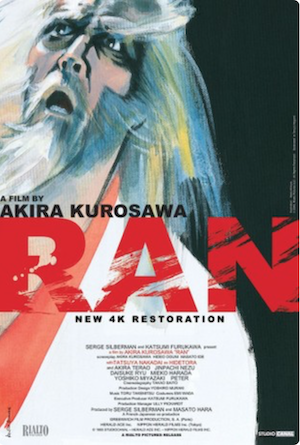“In a mad world only the mad are sane.”—Akira Kurosawa
As part of its “Re-Releases” series, the SLO Film Center at the Palm Theatre recently screened Akira Kurosawa’s 1985 Academy Award-winning film Ran in honor of its 40th anniversary. Restored in 4K and based on an original negative, the majority of the restoration work was done manually, image by image.
The 1985 action/war film Ran, by one of the greatest directors of all time, was inspired by Shakespeare’s King Lear. It’s the story of the retirement of Lord Hidetora Ichimonji, who divides his land between his three sons. This results in an outbreak of chaos—the English translation of the film’s title—as the sons compete for power.
The first-ever Akira Kurosawa film that I have seen in color blew me away with its breathtaking and sophisticated cinematography. Kurosawa is known as a master of shot composition, and his craft has been elevated to another level with access to color. That’s what makes one shot of the warlord walking out of his castle as it burns—regarded as one of the best in cinematic history—so powerful.
Kurosawa uses color to drive the story, especially when the movie literally gets darker as the plot descends into violence. Each and every shot is not only meticulously crafted, but intentional and put in place to push the plot further.
 Ran’s production values are unlike any other of his works. Its costume design stands out the most, winning the 1985 Academy Award. Kurosawa was almost fully blind during production, and assistants helped direct shots using the storyboard he had previously painted. In fact, many shots look almost like paintings.
Ran’s production values are unlike any other of his works. Its costume design stands out the most, winning the 1985 Academy Award. Kurosawa was almost fully blind during production, and assistants helped direct shots using the storyboard he had previously painted. In fact, many shots look almost like paintings.
Kurosawa, intentionally avoiding the use of close ups in order to strip away any sort of personal feelings the viewer may have, emphasizes how inhumane war is.
Some viewers may feel lost during the film as they search for morals, but to search for a moral in this film is pointless. Ran is chaos. It’s a film about human decay, and how morals fall apart when faced with greed.
No lesson is to be learned, which is very nihilistic for Kurosawa. He was going through tough times during production, from crippling debt, to the loss of his wife mid-production, to losing his vision. His pessimism might also be credited to the state of Japan following the bombing of Hiroshima: Kurosawa has said that Ran is an analogy for the advancements of nuclear weaponry and the impending threat of nuclear war.
The warlord begins to regret the decisions he’s made as death becomes more inevitable. He descends into insanity, tortured by the ghosts of his past and the violence he has inflicted throughout his life. The final shot, one of the only closeups in the film, is one of the most memorable: a blind man almost falls off a rooftop and drops an image of Buddha, no doubt representing the godless nature of war and greed.
The greatness of Kurosawa is the timelessness of his work. He strips away anything unnecessary, which makes his themes, characters, and messages always relevant; Ran will be regarded as one of the classic masterpieces of cinema for years to come.
